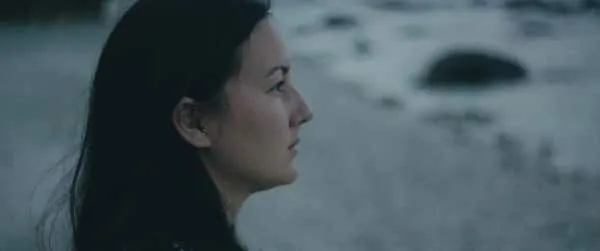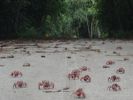Eye For Film >> Movies >> Island Of The Hungry Ghosts (2018) Film Review
Island Of The Hungry Ghosts
Reviewed by: Amber Wilkinson

From the start, we could be watching a horror film. It's dark and the jungle is alive with the noise of a thousand creatures, then a shadowy figure is seen running fast, panting hard through the undergrowth. A snatch of radio reports on the body of an asylum seeker found at the base of a cliff and suddenly we're not in the safe environs of the fictional world, but thrust into the altogether more real-life purgatory suffered by those who are detained - indefinitely - at one of the asylum seeker centres on the Australian territory of Christmas Island.
Debut director Gabrielle Brady doesn't want to shower us in statistics, we are left to work out the back story for ourselves, perhaps in itself a stinging indictment of a world grown all too familiar with waves of migrants seeking a better life who find incarceration rather than a pot of gold at the end of their rainbow. Instead of facts, she presents us with a snapshot of the migrants' situation as seen through the eyes and experience of trauma counsellor Poh Lin Lee. She lives with her husband and two young daughters on the island, we see her at play with them or exploring the more wild aspects of the environment. Like children everywhere, one of their favourite questions is: "Why?" Something Lee finds hard to answer when the subject strays away from the island's native crab population and back to those who are detained, often split from their families and with no end date in sight.

Brady doesn't need to label parallels between the nature footage she shoots of land crabs marching steadfastly toward the sea on migration. Instead, she uses these moments - often involving humans giving the animals some sort of helping hand - as a way of interspersing the film's more harrowing therapy scenes. It allows us to forge our own connections, using the natural world as a backdrop for our own contemplation. Also woven into the story, are the rituals of Chinese migres to the island, intended to help the souls of those who died without burial. Although this element could benefit from further bolstering, it nevertheless adds to the emotional fabric of the film, which builds a tapestry of ideas about freedom or the lack of it.
The therapy sessions sit at the film's heart. People, hands in a box of sand, create small scenes while talking about their heartbreaking experiences. One speaks of the connection between herself and her child, another of self-harm, a third of the desolation at being split up from his mother. Brady's camera is respectful, hanging back and letting these people speak for themselves, gently guided by Lee. We come to realise that Lee, too, is affected by the trauma, by her inability to work through issues with clients who are often moved to other islands - Nauru or Manus - without warning and with no continuation of care. The sense of isolation is enhanced by Aaron Cupples' otherworldly, experimental score - his first for a feature film. Created, according to the press notes "most entirely with oversized, stretched and augmented wire instrumentation" the effect is eerie and the tone befitting the film's themes and the island's essential wildness. Brady doesn't want us to feel good, she wants us to feel the connection. She succeeds.
Reviewed on: 21 Apr 2018
















